Continued investment in oil and natural gas is critical while carbon capture and removal technologies will play a key role in meeting decarbonization targets, according to oil and natural gas supermajor bp in its 2024 Energy Outlook.
BP’s energy outlook assesses two scenarios: current trajectory and net zero. The current trajectory scenario is meant to reflect where the global energy system is headed based on current policies and climate pledges while also taking into account the “myriad challenges associated with meeting these aims.” In this scenario, CO2 equivalent emissions “peak in the mid-2020s and by 2050 are around 25 percent below 2022 levels.”
The net zero scenario, also referred to as the “what if” scenario in the report, explores a global energy system where “the world collectively acts for CO2e emissions to fall by around 95 percent by 2050.” The aspirational net zero scenario assumes not only a tightening of climate policies, but a major, global shift in societal behaviors and consumer preferences.
Here are the key takeaways from the report:
“Peak Oil” and “Peak Natural Gas” demand look more like plateaus
In developing its energy forecasts across both scenarios, bp looks to several factors, including economic growth, energy and climate policy, changes in energy efficiency, and the adoption of new technologies.
As discussed in the Energy Institute’s recent 2024 Statistical Review of the World Energy, emerging economies play the largest role in driving global energy demand. The outlook explains:
“Growth in global energy demand is underpinned by increasing levels of prosperity in emerging economies. The extent and persistence of this growth depends on the pace of energy efficiency improvements.”
Across both of bp’s scenarios, the main factor to watch is growth in developing economies. Bp cites increases in these economies’ net energy demand – and what share of that demand is met by renewables versus oil and natural gas – as a key variable driving both energy demand and forecasted greenhouse gas (GHG) emissions.
Source: bp
While the “net zero” scenario projections make aggressive predictions about the decline of oil and natural gas use, the current trajectory scenario tells a different story, forecasting that oil demand will plateau – but still be needed – in the 2030s, in part due to increases in energy efficiency. Natural gas demand, however, is projected to continue rising through at least 2040.
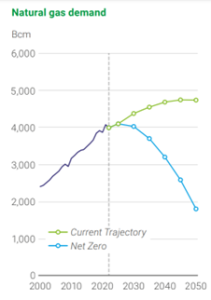
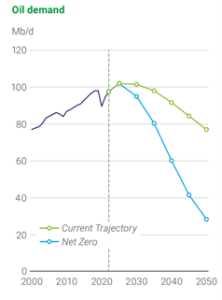
Source: bp
Furthermore, projected “peaks” in oil and natural gas demand should be taken with a grain of salt. In their 2020 Energy Outlook, bp predicted that demand for liquid fuels would peak in 2019 due to the fall in demand caused by the COVID-19 pandemic. On the contrary, 2023 was record breaking year for oil and natural gas demand, with oil demand overcoming the pandemic slump and surpassing 2019 levels. Similarly, EID has highlighted the problems with “peak” forecasts time and again where these bullish estimates may make good headlines, but often don’t square with reality.
Oil and natural gas remain critical across scenarios
Bp’s forecasts shows that oil and natural gas will continue to be a part of the global energy mix through 2050 — even in an ambitious net zero scenario.
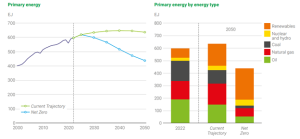
Source: bp
Per bp’s projections, as the share of renewables in the energy mix becomes greater, there will need to be dispatchable energy resources available when renewables are unavailable. Natural gas provides around-the-clock power that will complement renewables today and well into the future, especially as rapid adoption of artificial intelligence technologies puts additional power demands on the grid. Natural gas use in power generation is also responsible for the majority of carbon emission reductions in the power sector to date, proving it as an effective decarbonization tool.
The report also emphasizes the importance of continued investment in natural gas. Even in the projected “net zero” scenario, the world still needs investment in new upstream oil and natural gas production to meet projected energy needs, according to bp:
“Although the combined demand for oil and natural gas falls in both scenarios, natural declines in existing production mean that continuing investment in upstream oil and [natural] gas is required to meet future demand in both scenarios.” (emphasis added)
CCUS is key to meeting climate goals
Carbon capture, use and storage (CCUS) will play a key role in meeting decarbonization goals, particularly within hard-to-abate sectors. As the report explains:
“CCUS plays a central role in enabling the transition to a low carbon energy system: capturing industrial process emissions, enabling energy-based carbon dioxide removal, and abating emissions from the use of natural gas and coal.”
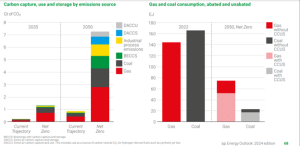
Source: bp
The need for carbon capture technology has been mentioned across stakeholders including at COP28 and from John Kerry, previous envoy for climate under President Biden:
“Science says we have to reduce the emissions. It doesn’t prescribe some particular discipline that has to be done; it says reduce the emissions… the science says we cannot get to net zero 2050 without some [carbon capture].”
Indeed, many oil and natural gas companies are actively looking to deploy CCUS in their own operations, but have been stalled by mixed messages and bureaucratic backlog from the Biden administration.
Bottom Line: Domestic and global policies, technology advancements, geopolitics, and many more aspects will contribute to the global energy mix as we approach 2050. As part of this, it is of the utmost importance that all-the-above energy strategies are implemented: from investments in scaling carbon capture and removal technologies to continued development in needed oil and natural gas. Oil and natural gas play a crucial role in meeting global energy demand, and they will continue to play a crucial role from now and through to 2050.
The post BP Energy Outlook Review: As Demands Rises, Oil and Natural Gas Remain Critical appeared first on .


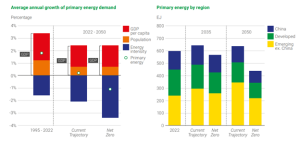

![Tesla reviewer breaks down the price of owning an EV versus a gas car in the US: 'Real costs after one year [of] ownership'](https://energynews.today/wp-content/uploads/2023/06/yahoo_news_en-US_s_f_p_168x21_news-90x21.png)






